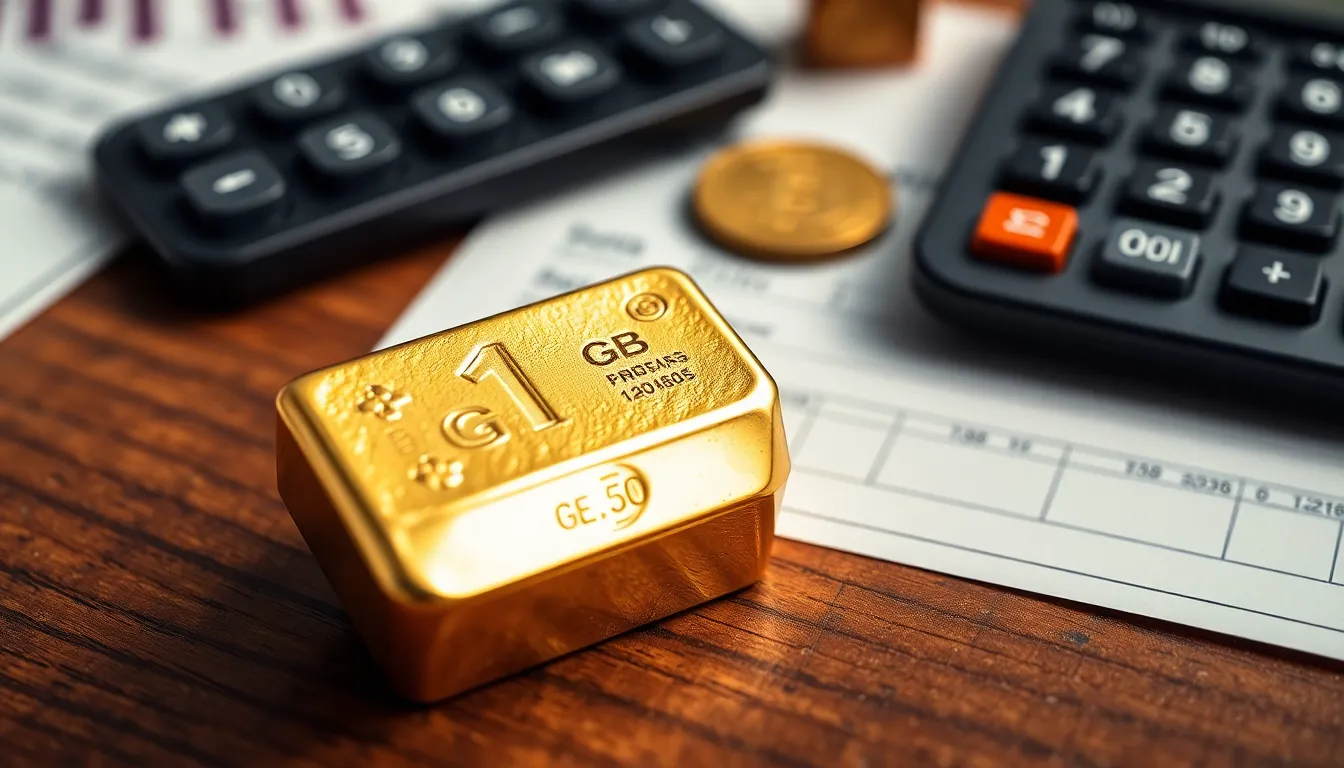Gold has always been the shiny star of the investment world, dazzling everyone from seasoned investors to those just looking to add a little bling to their lives. But how much is a gram of gold, really? It’s not just a matter of shiny aesthetics; understanding the value of gold can make or break a savvy investor’s portfolio.
Whether you’re planning to buy a golden trinket or considering a serious investment, knowing the current price per gram is crucial. After all, nobody wants to pay top dollar for something that could be found in a cereal box! Dive into the world of gold pricing and discover why this precious metal continues to hold its value, even when the world feels like it’s going haywire.
Table of Contents
ToggleOverview Of Gold Pricing
Gold pricing varies based on several factors, including market demand, economic conditions, and geopolitical events. Understanding these dynamics helps investors make informed decisions. The current price per gram of gold can fluctuate significantly; prices are often available in real-time on financial news websites and commodities exchanges.
Market demand plays a crucial role in gold pricing. For instance, increased demand for jewelry during holiday seasons can lead to price hikes. Additionally, central banks around the world influence pricing through their purchasing strategies. When central banks buy substantial amounts of gold, the market often responds, elevating prices.
Economic conditions further affect gold prices. Inflation and currency devaluation typically push investors toward gold as a safe haven. When the US dollar weakens, gold prices may increase, reflecting broader economic uncertainty. Furthermore, gold tends to be actively traded as a hedge against stock market volatility.
Technical analysis provides insights into price trends. Investors often analyze historical data to identify patterns that may forecast future price movements. This analysis can include observing support and resistance levels in gold pricing to make strategic investment decisions.
Other factors include the mining costs and geopolitical instability. Rising costs of extraction can impact supply, leading to price adjustments. Events like political unrest or trade wars often drive investors toward gold, thereby increasing demand and pushing prices higher.
Quality and purity of gold also determine its price. Differences in karat weight—such as 24-karat versus 18-karat gold—result in varying prices per gram. Understanding these differences is essential for buyers and investors alike.
Factors Influencing Gold Prices

Understanding the elements that impact gold prices is crucial for making informed investment choices. Several key factors play a significant role in determining how much a gram of gold costs.
Supply and Demand Dynamics
Supply and demand dynamics are fundamental to gold pricing. High demand for gold jewelry increases consumption, driving up prices. Conversely, if gold mines produce more than the market can absorb, prices tend to fall. Central banks also influence demand through their purchasing strategies. When banks accumulate gold reserves, they signal increased demand, which often leads to price surges. Fluctuations in consumer sentiment regarding gold’s desirability can also affect market dynamics. As awareness around gold’s investment potential grows, so does its demand, directly impacting pricing.
Economic Indicators
Economic indicators have a significant influence on gold prices. Inflation rates serve as key indicators; higher inflation typically leads investors to consider gold a safe haven. Currency devaluation further enhances gold’s allure, as it often retains value when fiat currencies weaken. Interest rates also play a critical role; lower rates decrease the opportunity cost of holding gold, prompting more investors to buy. Stock market volatility often drives investors towards gold for protection, affecting its market value. Economic data releases can lead to immediate reactions in gold prices based on investor sentiment.
Geopolitical Factors
Geopolitical factors greatly affect gold prices. When geopolitical tensions rise, demand for gold usually increases. Events such as conflicts, trade wars, and elections can create uncertainty, prompting investors to flock to gold as a stable asset. The strength or weakness of a nation’s government can also impact gold’s value. Safe-haven demand often spikes during crises, causing prices to surge. International relations and policies, particularly those related to trade and tariffs, also shape investor confidence in gold as a solid investment choice.
Current Market Trends
Gold prices continuously reflect the dynamics of the market. Several factors influence these prices, including historical trends and recent fluctuations.
Historical Price Trends
Gold’s historical price trends demonstrate its resilience and appeal as a long-term investment. In the last two decades, prices soared from around $250 per ounce in 2001 to an all-time high of approximately $2,075 per ounce in 2020. Economic crises and inflationary periods often triggered significant price increases, showcasing gold’s role as a hedge against uncertainty. During previous recessions, the price of gold frequently experienced substantial growth, affirming its status as a safe haven. Investors often analyze the past to predict future movements, establishing a track record of gold’s performance across various market conditions.
Recent Price Fluctuations
Recent price fluctuations in gold illustrate the commodity’s volatility. As of October 2023, gold hovered around $1,900 per ounce, influenced by factors such as rising interest rates and ongoing geopolitical tensions. The pricing for a single gram of gold is approximately $61. The combination of a strong dollar and shifts in central bank policies lead to daily variations. In specific instances, prices dipped when markets stabilized or when economic data indicated growth. Investors keep a close watch on these trends, and they frequently adjust their positions based on the latest economic indicators and geopolitical developments.
Where To Buy Gold
Purchasing gold requires careful consideration of where to buy. Options include online and physical retailers, each presenting unique advantages.
Online vs. Physical Retailers
Online platforms offer convenience and often competitive pricing for gold. Many reputable websites provide real-time pricing and a wide selection of gold products, such as coins and bars. Individuals can compare prices easily across different sites. In contrast, physical retailers provide the opportunity for face-to-face transactions and immediate possession of purchased gold items. Customers can inspect the quality and authenticity before buying. Both options serve different preferences, with online buying facilitating ease while physical stores offer personal interaction.
Reputable Dealers
Selecting a reputable dealer is crucial when buying gold. Verified dealers should have positive reviews and transparent pricing, minimizing potential risks. Companies with claims of industry membership, such as the Professional Coin Grading Service or the American Numismatic Association, often prioritize customer satisfaction and ethical practices. Long-established businesses typically offer greater assurance of quality and legitimacy. Researching the dealer’s history and obtaining references can also bolster confidence in a purchase decision.
Understanding the price of gold per gram is essential for anyone looking to invest in this timeless asset. With prices influenced by various factors such as market demand economic conditions and geopolitical events it’s crucial to stay informed. The fluctuations in price reflect not only the current market dynamics but also historical trends that shape investor behavior.
As gold continues to be a reliable safe haven during uncertain times investors should consider both the quality and the source of their purchases. By keeping an eye on market trends and selecting reputable dealers buyers can make confident decisions that align with their investment goals. Ultimately gold remains a valuable addition to any investment portfolio.




